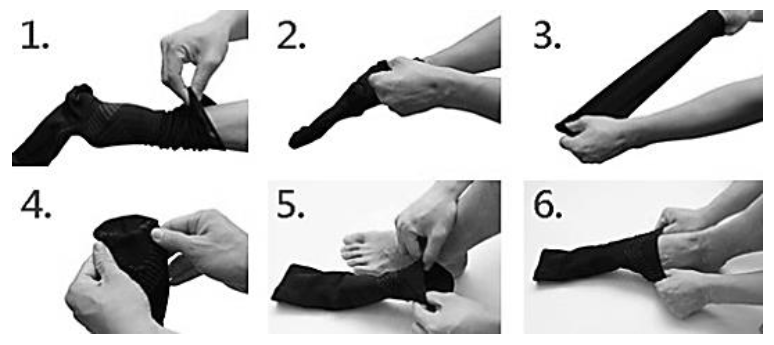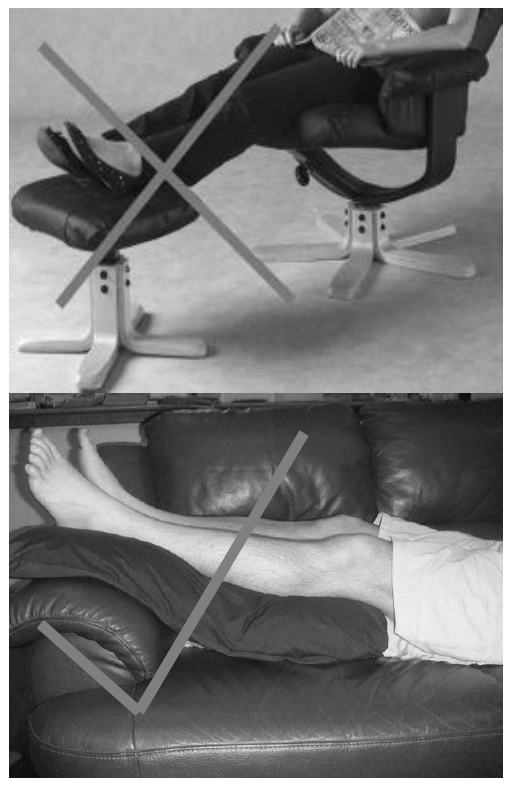Leg ulcer prevention
This page has been written to provide answers to some of the questions you may have about keeping your leg ulcer healed. If you have any further questions about your condition or treatment, please feel free to ask at your next clinic appointment.
Compression hosiery
You will be asked to wear a graduated compression stocking or sock once your leg ulcer has healed. These stockings/socks are designed to gently compress the lower leg. This pressure gradually decreases from the ankle to the knee, helping the calf muscles to pump the blood back towards the heart.
It is very important that you continue to wear your stocking/sock at all times during the day once your ulcer has healed. This will reduce the risk of having another leg ulcer. Do not hesitate to ask a member of the Leg Ulcer team or the nurses at your GP’s surgery for advice if you are struggling.
The stocking can be taken off at night. If you take the stocking/sock off, remember to apply moisturising cream to the skin. The moisturising cream will then soak into your skin overnight. You must also remember to put the stocking/sock back on when you get out of bed in the morning.
Compression stockings can be very difficult to put on, particularly if you are new to them. However, there are a number of tips to help you, these will be explained and demonstrated to you in the clinic.
Turn your stocking inside out, with the toe end tucked into the heel and place your toe in as far as it will go.
Gently ease the remaining part of the stocking over the heel.
Readjust the stocking by folding it back onto itself at the ankle and grab both sides of the folded stocking. Pull up as far as you can.
Use the palms of your hands to massage the stocking upwards towards the knee. Avoid pulling hard at the top of the stocking.
Check that the toe and ankle piece is in place.
Your stocking should fit smoothly, no creases or wrinkles.
There are a number of other helpful hints below to help when putting on your stocking:
- A range of stocking aids are available on prescription. These aids can assist in the putting on and taking off of your stocking. Please ask at the leg ulcer clinic or your local pharmacist for more information.
- Wear rubber gloves or put talcum powder on your hands as this will give a greater grip when putting on your stocking.
After your leg ulcer has healed
It is important to remember that the treatment of your legs does not stop when your ulcer heals. The following points will help you to prevent your ulcer returning:
- You will be given follow up appointments every 3 to 6 months by the Leg Ulcer Service for the first year.
- After the first year, you can contact the department and request an appointment when needed. This also means that you have easy access to advice and guidance. The telephone number is at the end of this page.
- There are 3 classes of stocking, Class 1, Class 2 and Class 3. These classes determine the level of compression the stockings apply. Compression stockings are also available in a range of colours and styles (including a man’s sock). Your community nurse or leg ulcer nurse specialist will advise you which class of stocking to use for your condition.
- Ask to be shown the range available. Below knee stockings are generally prescribed although thigh length stockings and tights are available.
- You must use new stockings every 3 to 6 months, depending on the type of stocking you have, as they will lose their elasticity after this time and will not work as effectively. The leg ulcer nurse specialist will advise you. Your compression hosiery can be supplied with a repeat prescription from your GP.
- When you attend your follow-up appointment, your leg(s) will be examined by the specialist nurse. Measurements will be taken and your stockings will be checked to make sure that they are still suitable.
- Please wear your stockings to all appointments to enable us to see how they fit and if they are still the most suitable for you.
Skin care
There are several skin problems associated with damaged or weakened veins in the leg. The most troublesome of these is venous eczema. This is an inflammation of the skin normally on the foot or leg which usually appears as a reddened rash that causes itching and soreness.
It is important to remember that compression is also a treatment for venous eczema. Creams alone will not cure this type of eczema.
High elevation of the limb will also relieve symptoms. You can achieve this by lying down with your feet raised above chest level.
Once your ulcer has healed, daily application of a non-perfumed simple moisturising cream and continuous wearing of your compression stockings will prevent varicose eczema in most cases.
Another common skin condition is staining. The brown stain is caused by the blood cells leaking into the skin due to the damaged veins. Unfortunately, this is permanent but can sometimes fade with time. However, it should not get any worse if you continue to wear compression stockings.
Hyperkeratosis is the over-formation of skin causing the leg to appear scaly. In most cases regular washing and the application of a moisturising cream can resolve this.
Dry skin build-up (hyperkeratosis) often appears to become worse when being treated in multilayer compression bandages. This will resolve once the treatment for your leg ulcer is completed and you are able to wash your leg more regularly.
Exercise
Keeping active is another important function to healing your ulcer. The action of walking causes the calf muscle to squeeze the veins and pump the blood back towards the heart. Without this pumping action, the blood will continue to collect in your legs due to gravity.
Try to avoid standing for long periods of time, for example when ironing, cooking and washing-up. If you do find yourself in a situation where you need to stand, try walking briskly on the spot or lifting your heels up and down. This will help to keep the blood circulating.
Diet
It is important for your general health to eat a well-balanced diet. This becomes more important when you are trying to heal your leg ulcer. Try to eat a diet which is high in protein, vitamins and minerals as these are the ingredients necessary for your body to heal.
If you are overweight, it is advisable to try and lose weight as this will help to reduce the stress on your circulation and help your ulcer to heal and remain healed.
Try to cut down on sugary and fatty foods such as cakes, biscuits, crisps and chocolate and replace them with fresh fruit, vegetables and carbohydrates such as potatoes and pasta.
Elevation
This is one of the most important aspects of the treatment of your leg ulcer. Elevating your legs with your feet above chest level encourages the blood to return to the heart. This reduces backflow in the veins and increases the healing process.
Elevating your legs on a stool while sitting in a chair will not help the blood to return to your heart. High elevation, as shown below, is the only effective way to help blood return when your veins are weakened or damaged.
We would advise you to elevate your legs in this position for regular periods during the day in addition to at night. When in bed, some cushions can be placed under your legs to raise them.
When your leg ulcer has healed, it is still important to elevate your legs to prevent them from swelling and your ulcer recurring.
Further treatment
Foam sclerotherapy is injection treatment for varicose veins. Most veins can be treated this way. However, some large or chunky veins might be better treated with surgery.
The treatment involves a special foam compound being injected into the vein in order to block it and stop leakage. This does not involve a general anaesthetic and will be done in the vascular laboratory as an outpatient treatment.
Foam sclerotherapy treatment is quicker, and carries fewer risks of complications than surgery. It also takes away the worry of having to come into hospital for any length of time. The specialist nurse at the Leg Ulcer Clinic will discuss the options with you and can provide you with written information to take home.
Contact information
Gloucestershire Leg Ulcer Service holds clinics across the county. You can contact the team in the following ways:
Gloucestershire Leg Ulcer Service
Tel: 0300 422 3480
Email: ghn-tr.legulcerserviceghnhsft@nhs.net
Please leave any non-urgent messages on the answer phone/voicemail when prompted. We will get back to you within 24 hours. We are a countywide service so we are not always in the office.
You can also find us on Facebook or Twitter


